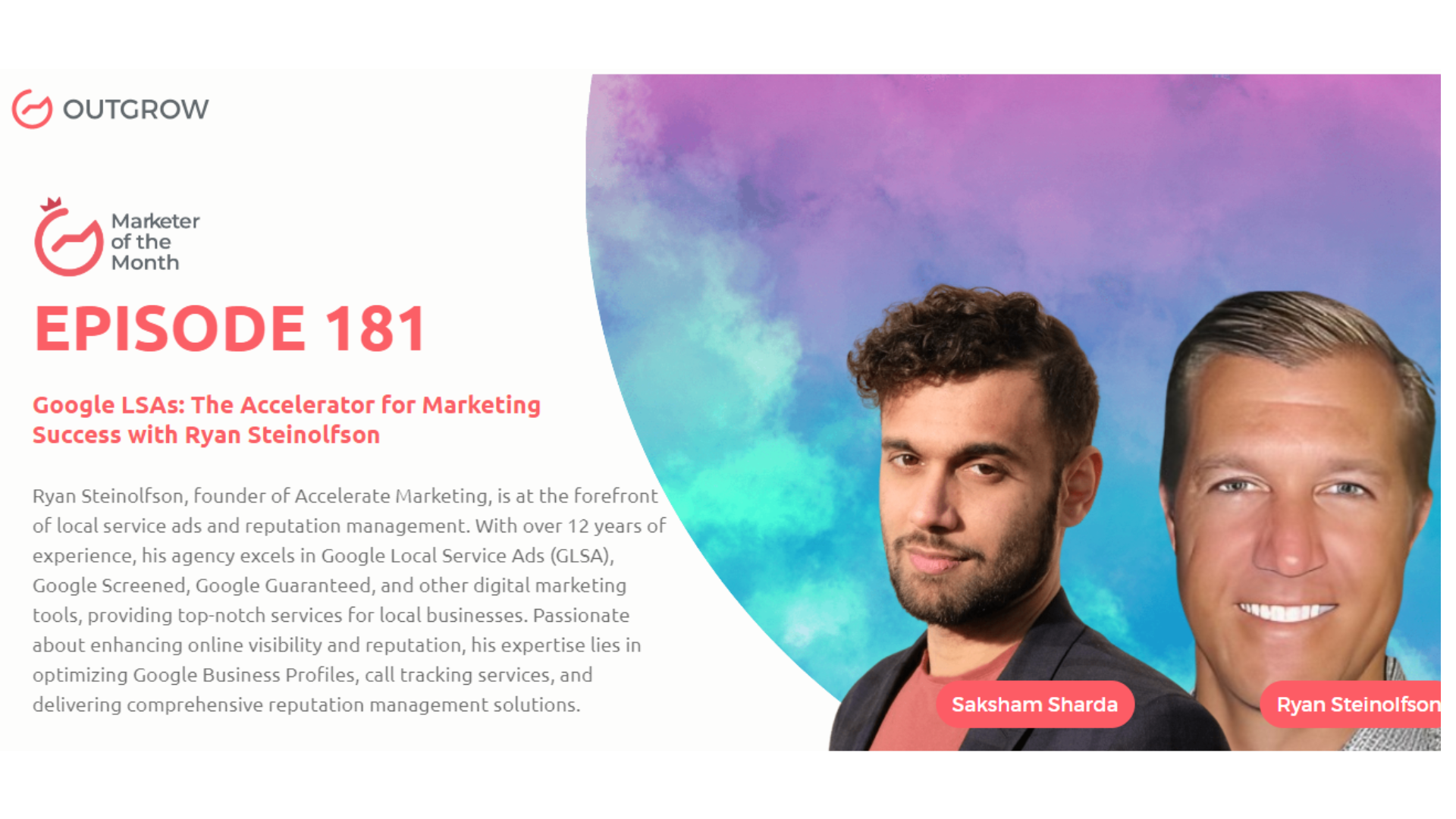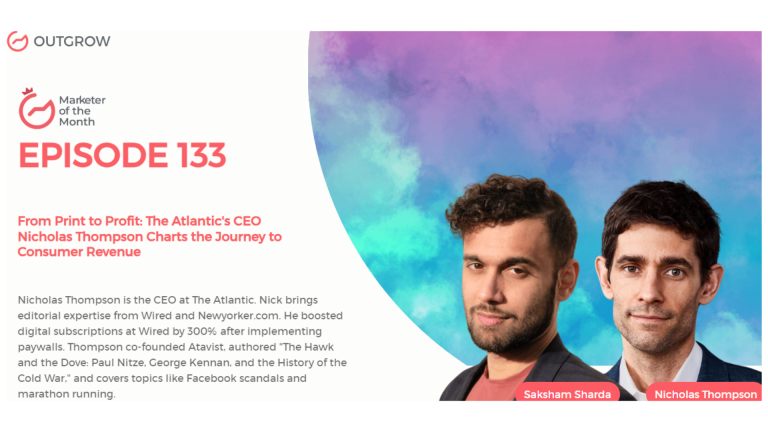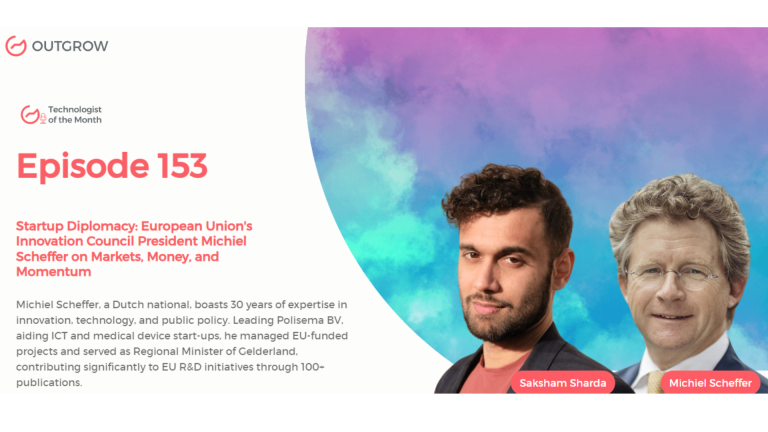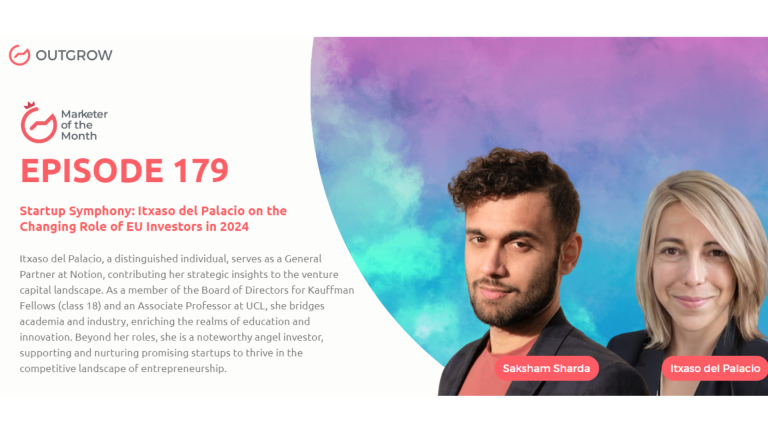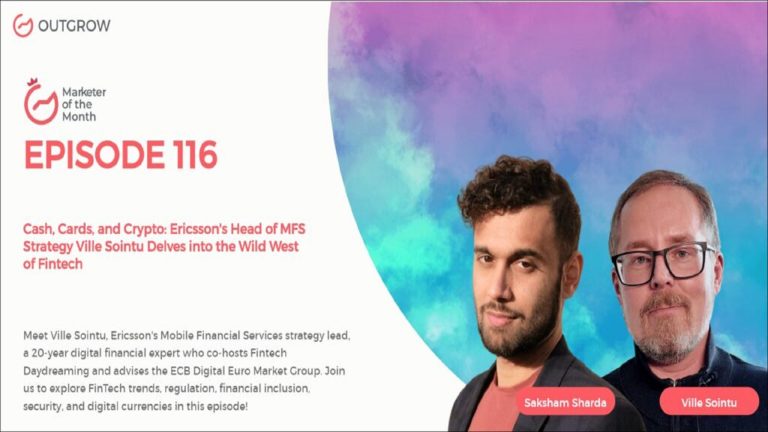Hey there! Welcome to the Marketer Of The Month blog!
We recently interviewed Ryan Steinolfson for our monthly podcast – ‘Marketer of the Month’! We had some amazing insightful conversations with Ryan and here’s what we discussed about-
1. Emphasizes the importance of Google LSAs and Maps for business visibility.
2. Discuss using CRM tools like GoHighLevel and CallRail to supplement Google’s limitations.
3. Describes the ideal client as someone willing to invest, increase budgets, and actively participate in the marketing process.
4. Highlights a diverse and unique schedule, involving communication with the team, podcast recordings, and client meetings.
5. Acknowledges the rapid pace of marketing and emphasizes the importance of daily practices like meditation to stay intentional and focused.
6. Expresses interest in growing own food through a food forest on a newly purchased property and the enjoyment of business as a team sport.
About our host:
Dr. Saksham Sharda is the Chief Information Officer at Outgrow.co. He specializes in data collection, analysis, filtering, and transfer by means of widgets and applets. Interactive, cultural, and trending widgets designed by him have been featured on TrendHunter, Alibaba, ProductHunt, New York Marketing Association, FactoryBerlin, Digimarcon Silicon Valley, and at The European Affiliate Summit.
About our guest:
Ryan Steinolfson, founder of Accelerate Marketing, is at the forefront of local service ads and reputation management. With over 12 years of experience, his agency excels in Google Local Service Ads (GLSA), Google Screened, Google Guaranteed, and other digital marketing tools, providing top-notch services for local businesses. Passionate about enhancing online visibility and reputation, his expertise lies in optimizing Google Business Profiles, call tracking services, and delivering comprehensive reputation management solutions.
EPISODE 181: Google LSAs: The Accelerator for Marketing Success with Ryan Steinolfson
Table of Contents
The Intro!
Saksham Sharda: Hi, everyone. Welcome to another episode of Outgrow’s Marketer of the Month. I’m your host, Dr. Saksham Sharda, and I’m the creative director at Outgrow. co. And for this month we are going to interview Ryan Steinolfson who is the Founder of Accelerate Marketing.
Ryan Steinolfson: Great to be here. Thank you.
Don’t have time to read? No problem, just watch the Podcast!
Or you can just listen to it on Spotify!
The Rapid Fire Round!

Saksham Sharda: So, Ryan, we are going to start with a rapid-fire round. Just to break the ice, you get three passes in case you don’t want to answer the question, you can just say pass. But try to keep your answers to one word or one sentence only.
Ryan Steinolfson: Okay.
Saksham Sharda: All right. So the first one is, at what age do you want to retire?
Ryan Steinolfson: Never.
Saksham Sharda: How long does it take you to get ready in the mornings?
Ryan Steinolfson: Immediately.
Saksham Sharda: Most embarrassing moment of your life.
Ryan Steinolfson: Pass.
Saksham Sharda: Favorite color?
Ryan Steinolfson: Blue.
Saksham Sharda: What time of day are you most inspired?
Ryan Steinolfson: In the shower.
Saksham Sharda: How many hours of sleep can you survive on?
Ryan Steinolfson: Seven.
Saksham Sharda: Fill in the blank. An upcoming marketing trend is _____.
Ryan Steinolfson: AI for voice. Conversational AI.
Saksham Sharda: The city in which the best kiss of your life happened.
Ryan Steinolfson: Jupiter, Florida.
Saksham Sharda: Pick one, Mark Zuckerberg or Elon Musk.
Ryan Steinolfson: Elon. All day.
Saksham Sharda: The biggest mistake of your career.
Ryan Steinolfson: No mistakes.
Saksham Sharda: How do you relax?
Ryan Steinolfson: Getting in the water, Ocean.
Saksham Sharda: How many cups of coffee do you drink per day?
Ryan Steinolfson: Zero.
Saksham Sharda: A habit of yours that you hate.
Ryan Steinolfson: It’s all good.
Saksham Sharda: The most valuable skill you’ve learned in life.
Ryan Steinolfson: Calming down. Like bringing it down.
Saksham Sharda: Your favorite Netflix show.
Ryan Steinolfson: I don’t watch any Netflix or YouTube. It’s all YouTube.
Saksham Sharda: Favorite YouTube show?
Ryan Steinolfson: I’d say like Ancient ancient civilizations.
Saksham Sharda: One-word description of your leadership style.
Ryan Steinolfson: Open.
Saksham Sharda: Top priority in your daily schedule.
Ryan Steinolfson: Meditation.
Saksham Sharda: Key factor for maintaining a work-life balance.
Ryan Steinolfson: Fun.
Saksham Sharda: Memorable career milestone.
Ryan Steinolfson: Hitting a million dollars a year.
The Big Questions!

Saksham Sharda: Oh, okay. Well t, that’s the end of the rapid-fire round. That was quite high-end. So let’s go into the main questions, which you can answer with as much ease and time as you like. The first one is, how does one accelerate marketing in this age of AI content everywhere?
Ryan Steinolfson: For a while. Alright. It’s tough. a guy that likes to talk, you know, like, you know, using just one word is tough. My team would’ve been proud of me, like having me go through that. So it’s really simple actually because we’ve been doing it for about 15 years now. And in this day and age for an agency to be around any more than even four or five is, is a long time. And during that time, a lot’s changed and a lot stayed the same. And so one of the things that stayed the same, because people are still searching on Google and they’re still typing in business near me or pets near me, or, you know, pets that are near whatever they’re looking for. And the number one way that people are still finding businesses is still on the, a lot of them are looking for those, the search results at the top. And so Google is, you know, it’s got the maps and it’s got now Google screen. And so that’s why we focus on just those two things: Google local service ads and Google Maps. And if A AnMB or a small to medium-sized business is in those areas in those two sections, and they’ve got a decent number of reviews, which we help ’em with, and they’re using ai, that’s the wrinkle. A conversation which we have a solution for. Thank God. We finally, after two years, found a solution to answer the phone using AI for our clients so they can have a hundred percent response rate. That’s the key to generating a constant flow of new pre-qualified pre-sold leads, is to make sure that the phone is being answered every single time, if not by your team for the first 20 seconds, which is what we do. We give the internal team about 20 seconds to answer the phone and then we let it flip over to AI so that all the calls are answered within that 32nd period Google wants. And that’s the main ranking factor for local service ads. And that’s what almost every single business is not doing. So we finally have a solution for that. It’s using AI in a way that most people don’t know you can use and we can even make it sound like your voice. So it sounds like the owner when the AI picks up. And we do that for not only voice calls, but also for message leads. That is a technology that is rapidly growing and new agencies are being created right now just to master or to help businesses utilize conversational AI for their businesses and integrate their CRM, for example, into the AI so that the AI can process the conversation by looking at and referencing the CRM and seeing if it’s an existing customer or not. And then taking that information and having a contextual-based conversation based on the products or services that they’ve already purchased or used or any past conversations that they’ve had. So it’s got a complete recollection of who those existing clients are. And it can even do things like qualify somebody that’s not an existing client by looking at other databases. So anything that can be connected to the can be accessible to the AI. So think about that. I mean, that all can be going on in the background while a full conversation is going on, which is much different than, I don’t know if you’re different than me, but you know, most guys, they say girls can multitask, females can, but guys, we’re not. So we’re not rede, we’re not rede to multitask. We’re made to focus on doing one thing and doing it. Well, you know, the AI can do hundreds or thousands of things at the same time. They can qualify somebody while having a conversation with as many people at one time as you want it to have. So there’s no limit to the number of people that AI can handle at any given time. Therefore all the phones will be answered and they can go and they can, they can qualify them, they can do all kinds of amazing things while that conversation is happening not only for voice, but also for message leads, which is great. So, this is a big challenge because a lot of people use the local service ads, and the two options to contact that business are either through voice or message. And most people don’t even turn the message leads on because they don’t know how to respond. They don’t know how easy it is to have message leads fit into their intake processes. So t, therefore t, they don’t even, they don’t. And those leads are half the price and they typically convert at least probably about a 10 to 15% higher rate than voice leads as well. And they’re easier to handle once you get them. Anyway, that’s what I would do. I mean that we have kind of an ascension ladder for our clients and the place that we start them with is acting up call tracking so that we can track all the phone calls first, because if you’re not tracking calls, what are you doing? You know, I mean, I don’t want, we won’t even take on a client now unless the client that we’re gonna work with will either have call tracking or is willing to get call tracking because I want that client or the clients that we work with to know beyond the shadow of the doubt exactly what kind of value that we’re bringing in terms of, and not, not only that, o that we can hold yourself accountable. Because a lot of times what I’ve heard in the past is clients saying, well, we haven’t gotten really that many leads. Well, if we can listen to the calls and we can determine if they’re ACOD leads and what the return on ad spend is, then it’s, it’s hard to argue with a ROAS number like a return on ad spend. So if we’re getting somebody at least a three x return on ad spend, you know, that’s our minimum, then I think that you know, that’s a good thing. So it’s, we don’t like, we like dealing in, you know, specifically in black and white numbers a, and otherwise it’s just too ambiguous. You know, if we’re dealing with, oh, well we don’t know exactly how many, you know, phone calls you generated for us, it’s like, no, this is how many we generated. This is what your typical day has been, you know. Yeah. So what does your typical client look like? Great question. We’ve set an avatar that we’ve developed and my team has gotten rid of this. I mean, they, you know, for a while I was the sales guy and so they, you know, my new operations manager, not new anymore. She’s been with me for over three years now. She’s amazing. She and I have worked out a really good avatar because for a while there we were taking on clients, and this is one of the reasons why we’ve grown so much in the past three years is the cause, and it sounds counterintuitive, that you are more restrictive with who you take on. And yet we grow more, we might not grow in our top-line gross revenue, but what we do, what we do grow in our net revenue. That’s the amazing thing. We grew our net revenue from almost 20 to 25%, almost 50%. That’s a huge profit percentage. I mean, that’s like, I don’t think there are so many other agencies out there that have that kind of a, of a, you know, a profit percentage. I mean, typically it’s around, you know, 20, 25% if that we’re, we’re, we’ve, we’ve exceeded 50% in certain months this past year because we’ve gotten super specific on who we take and we don’t. And when I talk to people, when I talk to prospects and they call me from typically my YouTube videos, etc that I’ve got out there, which by the way is an amazing channel for lead gen. I mean, it’s still, I mean, I know it’s been used for a long time. I love the lead gen from YouTube because I can educate people and get them to a certain point before I even talk to them so that they’re prepped for the call. I mean, they know about the three R’s, the reviews, radius response time, they know the mantra that I’ve got. So it’s, we’re already, I’m already talking to somebody that’s already educated, you know, and that’s a good thing because then I don’t have to spend as much time helping them understand who we’re looking for because a lot of times I’ve already qualified them in the, in the YouTube videos. After all, they know that if they’re not dealing with their response rate, if they’re not dealing with their getting reviews every week, at least two reviews a week, and if they’re not optimized in terms of their radius, which, you know, we’ve got ways to do that, then they’re just, they’re that they’re not a good candidate, number one. I mean, and or if they’re not willing to do something about it, it’s okay if they, if they’re not doing anything about it. And, if they’re gonna tell me when I’m on the call that they’re not willing to do anything about it, then it’s like a red flag. You know, we use red flags and green flags, you know, it’s like green flag, red flag. So, our team’s constantly saying, you know, this is a red flag, this is a green flag. So the other thing that we’re looking for is not only somebody willing to work on those things, it’s also they there are a few other things that we look, we look for if we get to the return on ad spend that we’re looking to get to, okay, in other words, it, are we able to generate a return on ad spend that’s at least three x? Will they increase the budget? Because outside of Google Maps optimization or not, you know, Google business profile optimization, which is primarily an organic strategy, the local service ad strategy is one where you have to pay to play just like Google Pay per click. It’s just primarily for local businesses. And if we get to a certain budget spend and that person has spent their budget and we have maintained a certain cost per acquisition that we’ve agreed upon in the beginning, and based on what their income is, and we know that every new client that they acquire is, let’s say we acquire ’em for $500 a piece and we’ve, and they’ve told us that the average amount they make for a client, let’s say it’s an attorney and they’re making 5,000, well that’s a great return on ad spend. I mean it’s, you know, they’re paying $500, they’re making 5,000. And as long as we maintain that relationship of cost per acquisition and to how much their income is, I just want to get an agreement in the beginning that if we keep that, they’re gonna want to increase the budget. They’re gonna keep wanting to, you know, increase the amount that they spend. So unless we have somebody willing to do that or start at a budget that we’re looking for, that we need to start at in the beginning, because Google knows, ’cause we’ve tested this out, especially for local service ads. So all you agency owners out there that I don’t know who you’re, you know, probably some agency owners are gonna listen to this. A lot of agency owners that I’ve spoken to don’t know this about local service ads. So this is a good thing to know that, ’cause we’ve tested this, that a lot of areas or a lot of verticals if you don’t start wi certain budget amount per week, per month, they’re just not gonna send you the, the volume of leads we’ve experienced that Google will not see volume or the really the quality as well of leads to your And so we have a minimum that we like to start with. And a lot of times it’s a little bit more than some of these small, medium-sized business owners want to commit to. And that tells us something also about them as well. Are they ready to start a campaign like the one that, you know, we want to want to do with them as well? So, you know, we just wanna know that you know, who we’re dealing with and ’cause some people they just wanna like to dip their toe in and you know, it can be a little challenge, it can be challenging for us because if we’re spending our time onboarding somebody that just wants to kind of try it out, we’re limiting our capacity to bring on another client that would want to go full bore and has the budget and has the scalability to grow with us so that we can, you know, really make a big impact on their business. We want to work with businesses that want to grow and that is great to make an impact and grow. So those were a couple of things. I mean, there’s, I could, there’s many more.
Saksham Sharda: The conversational AI that you’ve been talking about must have been something very recent and I guess only from last year onwards that we have seen such progress in AI. So all this growth that you have seen through this tactic has happened in the past year.
Ryan Steinolfson: Yeah. So it’s funny, we haven’t even, we’ve just experienced that growth without even the AI, we’re just launching the AI this week. And if anybody, yeah, if anybody wants, and we are gonna white label our service to other agencies as well. So we’ve been developing this conversational AI tool along with software for local service ads that allows business owners to manage their local service ads because it allows them to see what their response rate is. Because if you don’t have what’s called an MCC account or a master client account, you can’t see what your response rate is. So a lot of business owners that only have one location, which is probably 80% of businesses out there, can’t see what their response rate is at all. And so our software allows them to do that and to go back and look back more than the three months that the current LSA software allows you to go back and look. So you can see the trends and you can see the correlations with lead volume and response rates. So as lead volume goes up to, you know, response rate goes up, and same with reviews. So we graph that over time so that we can show our clients and help them commit to wanting to improve the reviews and the response rate because they can see the data, they can see the correlations. Because Google doesn’t, you know, Google’s not known for their customer service or their graphs or their, you know, they’re pretty close to their chest with their business intelligence and their data. So we are just representing it in a way that makes it easy for people to understand the connection between the three Rs that I’m, that I talk a lot about in my YouTube videos.
Saksham Sharda: So is there any CRM system you use to supplement everything that’s happening?
Ryan Steinolfson: Well, like a lot of agencies we, we bought in to go high level in the beginning you know, for ourselves and a lot of our clients use it as well. And we can connect through the API to the AI which is amazing because that, you know, allows us to pull in that data that I was talking to you about. And, you know, I like to go high level, it’s like a Swiss Army knife. It’s got a lot of different, you know, a lot of different tools. Not all of them are the best at what they do. For the call tracking, for example. It doesn’t do all the things that, at least not yet, we need call tracking to do. Like simultaneous calling of as many numbers as we want at the same time. I don’t know if they’ve fixed that, somebody let me know because I would love to be able to use the level and keep everything in one place. So, you know, we use CallRail and we’re partners with them.
Saksham Sharda: Any CRM tools you use to supplement the disappointments of Google that you mentioned earlier?
Ryan Steinolfson: Yeah. I mean, you know, the other verticals that we work in or that we work with all have their own specialized, you know, CRMs that they use, the service-based businesses. A lot of them use like, you know, service titans and stuff and, and you know, the law verticals have their own that, you know, very specific ones. But yeah, it’s if, and there’s very few clients that at this day and age that, that we work with that don’t have one, which is great.
Saksham Sharda: So what does your typical day look like? Walk us through your typical day at work.
Ryan Steinolfson: A typical day at work is, every day is very unique. I can tell you that now it’s much different because we do, I do have people that are selling for us. So I used to, and I enjoy selling. Before I did this, I was in biotech sales and so I used, you know, I was, I’ve always been in the sales arena. So it’s nice as the owner and of the company to just, you know, see higher level things and work on higher level things and not just selling. Although I do get involved in sales still, which I enjoy a lot. A lot of my day is spent communicating with the programmer after I get up and I do my yo practice yoga, I’m, I do, I have a lot of I just went to one of Sad Guru’s events and we learned sir Shati and some of these other practices that we do daily in Koreas. I just got done doing those actually, before our meeting. And, and part of that is meditation twice a day, which is great. But so it’s, you know, I’m just interspersed with, it’s whenever I, because a lot of these practices have to be done on, or should be suggested to be done on like four hours of not eating. So I’m constantly, you know, figuring out, you know when lunch when dinner is, and then, you know, having all these calls with you know, these business calls and stuff. It’s just every day is a little bit different, you know, in terms of what’s gonna work. And I have a lot of Zoom calls and I do podcasts and I record videos as well from my YouTube channel. Thank god I’ve got the studio here at the house and yeah, so it makes it, it makes it easy. And I’ve got all the lights and everything. It looks crazy in here because we’ve got lights all over the place too, you know, so I can have meetings wherever I want to, but yeah, so no typical day.
Saksham Sharda: And do you find yourself overwhelmed by the speed of 21st-century marketing or the meditative things that you have around you? Are they a safeguard for this? Or what is happening with Accelerating Marketing in today’s age?
Ryan Steinolfson: Yeah, it is going, it is going faster and faster, you know, I mean, things are it, and that’s why I purposefully take time during the day to do these practices because otherwise it just, the pace can be, can be so frenetic. And what I found is, the paradox is I can do things much more intentionally and get things done more effectively instead of, you know, the grind that everybody talks about. It’s like making deeper connections and finding out not only with our clients but also with our team, with my team to make sure that I’m present. If I get so wrapped up in what my team used to call go mode when I was having two three or four cups of coffee a day, then I will not be able to connect because while I was meeting with you, I was thinking about what’s happening or what’s gonna happen at one o’clock and what happened earlier and what’s gonna happen tomorrow instead of connecting and being present in the moment with you or my employee or my girlfriend or anything that’s going on. And I think that in today’s era, and just in today, you know, I think that I know that I was doing that and so I’m constantly doing the best I can to do breath work, to do the media, do meditation, to slow down to just to catch my breath and to make, to check in really to make sure that I’m ready for the next meeting and that, you know, that my breath is modulated so I’m not, you know, just going, and I’m able to get done and you know, what I need to do for the day.
Saksham Sharda: So turning back to your clients for a bit, since you work with a lot of local businesses, is it not sometimes the case that there’s a conflict of interest and there’s two businesses in the same area?
Ryan Steinolfson: Yeah, a lot. That used to happen a lot. Second, I mean, so, most other agency owners back in the day, especially when we were doing, you know, SEO, that it was so funny because you’d get these exclusivity clauses that would be signed, and especially in these very highly coveted verticals like attorney work or plastic surgeons that, you know, where the amount of income that they get for each one of these new leads or these new clients that they get is, and there’s big, there’s very high stakes. And so, you know, the rankings that io those agencies and all the big agencies would have, you know, a rider on top of their agreement that says, okay, you have exclusivity in this specific area for, for search engine optimization. And I understand that because there’s only one position that you can get in or be in the, well, there’s only one company that can be in the first position, you know, with, and that’s the thing I like about local service ads is that a lot of what we do is dependent on our client’s ability to do what we’re working with them on. So it’s not so much all of what we do as an agency to optimize the client. It’s the three Rs, it’s reviews, radius response time. And that’s one of the reasons why I came up with the solution of artificial intelligence or conversational AI answering the phone, is because it was driving me nuts that I couldn’t help the client control something that was out of their control. Because almost every client wasn’t aware of what was even happening with their intake team. They didn’t even know that ev almost every single time to a person that I asked, what do you think your response rate is? How, what percentage of calls do you think your team answers? And 95% of the time they would say, oh yeah, answer a hundred percent of our calls, every one of ’em. And I mean, I would have three calls, two, three calls a day, same thing. And I just, and that’s why I got so singularly focused on solving this one problem because they didn’t, these business owners, it was a tail wagging the dog. I mean, they didn’t even know. They didn’t know what they didn’t know. And they were doing, wearing so many hats that they were unaware of what was happening at their most fundamental level. You know? Right. When the person, you know, that’s like when business starts, that’s like at the very beginning, you know, it’s like you have 20 seconds to make an impression. You know, this is the reason why Google expects all calls to be answered in 30 seconds, because that’s like, that’s like at the time that it starts and at that fundamental time, you know, ’cause all these other things, all these other hats are being worn. They don’t know what’s even happening there. And so we needed to provide a solution we have. And outside of that, you know, everything else or a lot of the other things that we work on with our clients are things that we’re helping them do. You know, we’re automating some of the review gathering and the biggest opportunity for us is to do what we call, which is a review culture training, where we shift their culture into one where they all become one of the review gatherers and they get more reviews, they get better reviews that way they get, you know, more meaningful reviews that way. And Google can see when it’s being done the right way, you know, they see all the funky stuff that goes on with a review gatherer. Google knows what’s going on. I mean, their AI is one of the smartest AIs out there. So they can follow all, they know who’s breaking the rules and who’s not. And so my point is that you know, we do have a writer or anything, any additional agreement that says, Hey, you’re gonna pay $5,000 to just be the exclusive guy in this area because, you know it, a lot of what we do is dependent on us working with their team to get what we need to be done for them to rank in the three pack for local service ads. Now, Google business profile optimization, I would argue yes. I mean, because that is a ranking process that, you know, somebody could theoretically want to pay to have you work with them exclusively in one area versus another area. Although we don’t, we haven’t come across that in a long time, and I haven’t been asked that often, you know, to have that done. But it is something that, you know, is still being done out there from what I understand.
Saksham Sharda: Alright, so the last question for you is of a personal kind. What would you be doing in your life, if not this?
Ryan Steinolfson: Good question. You know, I, the other thing that I do and, and that I’m becoming passionate about is growing our food. So we’ve just purchased a property up in Palm City and Florida and five Acres, and we are gonna plant all our food forest and grow our food. Not just, you know, fruits and vegetables, but like, it’s a multi-layered forest so that you can, it’s much more productive than just a single crop on land and much better for the environment because it just, it’s so much, the environment’s so much healthier, not only for the local plants and fruit, I mean, and animals and things, but it’s also good for the, for the air. It sequesters so much more of the harmful pollutants in the air because it’s such a dense environment with plant life. So I’m looking forward to that. And you know, in terms of the business, I don’t look, I mean, I enjoy what we’re doing ’cause it’s cutting edge because it’s leveraging technology to solve a specific problem that almost every business has. Specifically with the AI, conversational AI, what fundamentally what I enjoy about business is I think it was who, I don’t, I forget who said it, was one of the Shark Tank guys that said, you know, business is like playing a sport. It’s because you’re on a team and it’s like a team sport. I think it was the guy who owned the basketball team, a tall dude with dark hair. I forget his name. Anyway, it’s like a sport and be, and the more, because the team can be made more efficient through training, the team can be made stronger through bonding exercises, things that would bring any other, you know, sports team together very similarly. And, you know, there’s a culture, just like a sports team has every, you know, sports team, all the famous ones, they all had their own little internal culture in the team, you know, and the same thing applies with the team, the business team. And it really, I think, you know, somebody else said this, I mean, when you fundamentally break down a company, it’s just the employees. It’s all the team itself and operating as one organism if you will. And so that’s what I find so fundamentally interesting about it, is that even though we’re delivering agency services, digital marketing, agency services, you know, we could be at the same time, you know, delivering any service. We could be a pest control company, and it would be the same thing. I enjoy what we’re doing specifically because I do enjoy the tech side of things and the cutting-edge side of it. That we’re cutting a new space, you know, that we’re opening up a new space. And, as I said earlier, some agencies are starting specifically just delivering AI, conversational AI, and specifically the connections to the APIs, that’s all that agency. There are whole new agencies now that are just doing that, and they’re getting paid millions a month. Like, you know, we’re, I don’t know that we’re gonna go to that. We’re gonna stay in our lane and continue to deliver our services, and then just add in the conversational AI to provide the solution that we need specifically for the services that we have.
Saksham Sharda: I was gonna say, but you said you also plan to white label it.
Ryan Steinolfson: We are white labeling it for other agencies and yeah, any business owners that want to test it out, we are looking to, you know, test it out all by itself without our services because just the AI itself. Because we want, we’ve got a little double texting issue that’s going on with the message leads because it sends, because Google actually sends two messages and then the AI wants to respond twice. So we just got a few little things to work out, but it’s amazing. And then, the calls that are being answered by AI are counted as answered calls, which is great. So yeah, it’s pretty cool.
Let’s Conclude!
Saksham Sharda: Thanks, everyone for joining us for this month’s episode of Outgrow’s Marketer of the Month. That was Ryan Steinolfson who is the Founder of Accelerate Marketing.
Ryan Steinolfson: Great to be here. Thank you.
Saksham Sharda: Check out the website for more details and we’ll see you once again next month with another marketer of the month.

